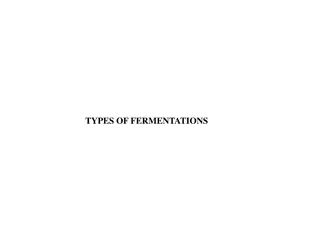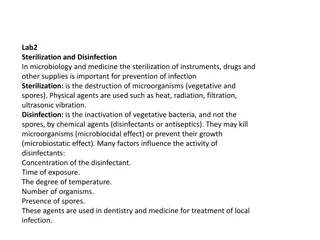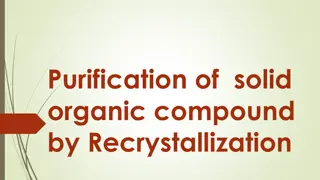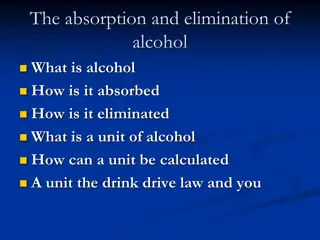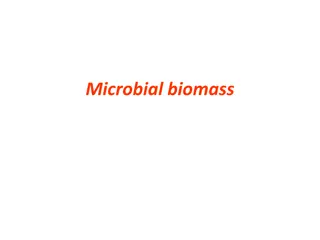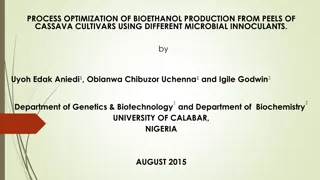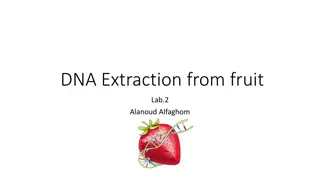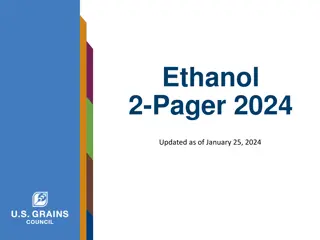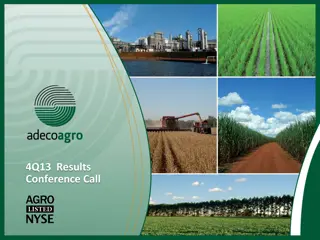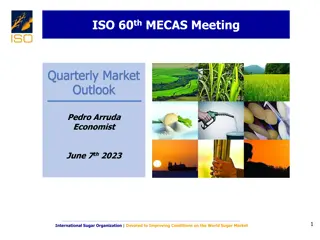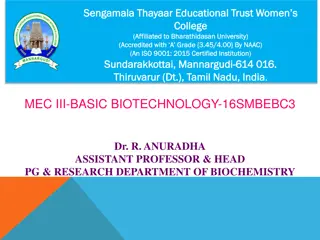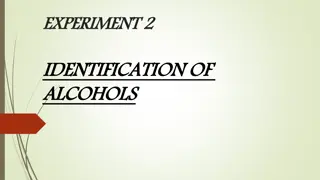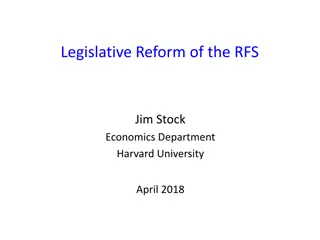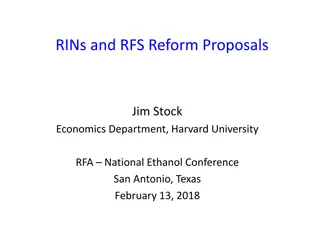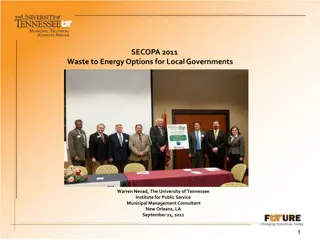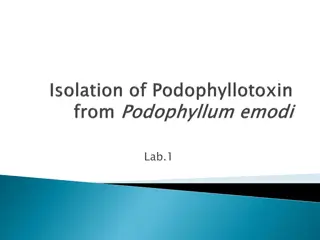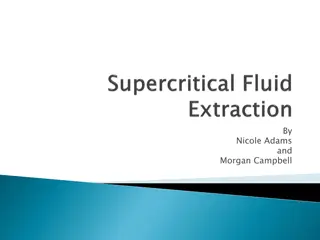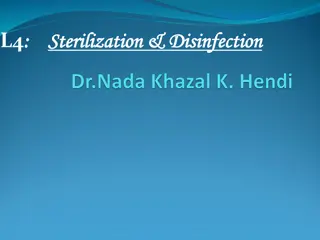Egypt Retail Fuel Stations Market
A fuel station, also known as a petrol station, gas station, service station, or filling station, is a retail outlet that sells motor vehicle fuel to vehicle owners. Fuel stations provide various fuels including diesel, petrol, gasoline, kerosene, and ethanol. The main components of a fuel station i
5 views • 6 slides
Ethanol production
Ethanol, produced through fermentation by yeast in oxygen-free conditions, serves as a chemical feedstock, solvent, disinfectant, and fuel additive. The biochemistry involves sugar breakdown to pyruvic acid, then conversion to acetaldehyde and finally ethanol. Yeast growth in rich medium leads to et
0 views • 21 slides
Achievements and Initiatives of Haryana Cooperation Department
Haryana's Cooperation Department has achieved significant milestones including paying the highest ever sugarcane price, receiving export orders, procuring food grains at MSP, enhancing warehousing infrastructure, and diversifying into new activities like ethanol production. The department has also f
5 views • 11 slides
Understanding Anthraquinone Glycosides: Pharmacognosy Insights
Anthraquinone glycosides are compounds found in medicinal plants like Senna, Cascara, and Aloe, known for their therapeutic actions. These glycosides are hydrolyzed to yield active aglycones, which act as stimulant cathartics by increasing smooth muscle tone in the colon. Market formulations and ext
1 views • 11 slides
Understanding Different Types of Fermentations
Alcoholic fermentation involves the production of ethanol, commonly carried out by yeasts like Saccharomyces cerevisiae. On the other hand, lactic acid fermentation results in the production of lactic acid through two types: homo-fermentative and heterofermentative pathways. Different substrates and
2 views • 23 slides
Understanding the Gram Stain Technique in Medical Microbiology Lab
The Gram stain is a crucial technique in bacteriology, dividing bacteria into Gram-positive and Gram-negative groups based on cell wall characteristics. This method involves using crystal violet, iodine, ethanol, and safranin to differentiate between the two types of bacteria. Gram-positive bacteria
0 views • 11 slides
Sterilization and Disinfection in Microbiology and Medicine: Importance and Methods
Sterilization and disinfection are crucial in preventing infections in microbiology and medicine. Sterilization involves the destruction of microorganisms, while disinfection targets vegetative bacteria using chemical agents. Factors affecting disinfectant activity include concentration, time of exp
1 views • 7 slides
Recrystallization for Solid Organic Compound Purification
Recrystallization is a laboratory technique used to purify solids based on their different solubilities. It involves dissolving an impure solid in a suitable solvent, cooling the solution to allow pure crystals to form, filtering to isolate the purified solid, and drying it. Finding a good recrystal
1 views • 11 slides
Isolation and Analysis of Alkaloids: Atropine, Quinine, Reserpine, Caffeine
Alkaloids are extracted and isolated based on their basic character and solubility patterns using processes like Stas Otto. The general method includes treating plant material with solvents, extracting with ethanol, and separating bases using various techniques. Atropine, obtained from plants like A
2 views • 28 slides
Understanding Alcohol Absorption, Elimination, and Units: A Comprehensive Overview
Alcohol, specifically ethanol, is absorbed through the stomach and intestines into the bloodstream within minutes, and it is primarily eliminated through breath, sweat, urine, and the liver. The concept of a unit of alcohol helps in calculating safe consumption levels, with factors like volume and a
3 views • 16 slides
Understanding Stereochemistry: Isomers and Their Properties
Stereochemistry explores the fascinating world of isomers, including stereoisomers, geometric isomers, and structural isomers. Stereoisomers have the same molecular formula but differ in spatial arrangement, while geometric isomers lack free rotation around bonds. Structural isomers like dimethyl et
0 views • 27 slides
Enhancing Ethanol Production Through B-Heavy Molasses Diversion
The Indian government has implemented the Ethanol Blending Petrol Programme to promote alternative fuels and reduce import dependence. Measures such as diverting B-heavy molasses for ethanol production aim to support the agriculture sector and manage surplus sugar production. This initiative involve
0 views • 21 slides
Industrial Applications of Microbial Biomass Production
Microbial biomass has various industrial applications such as the production of single-cell proteins, antibiotics, ethanol, and organic acids. This biomass can serve as a valuable resource for seed cultures, silage production, biopesticides, animal fodder, and more. Yeasts like Saccharomyces cerevis
2 views • 17 slides
Understanding Stoichiometry in Chemical Reactions
Stoichiometry is the concept of predicting the amounts of reactants and products in a chemical reaction, similar to following a recipe in cooking. It involves balancing chemical equations and determining the quantities of substances involved. By paying attention to coefficients, one can calculate ho
2 views • 65 slides
Guide to Ethanol Production from Corn: A Student Lab Experiment
Explore the process of ethanol production from corn through anaerobic fermentation, with students testing their procedures in a lab setting. From preparing the samples to distillation, follow step-by-step instructions accompanied by helpful images.
0 views • 22 slides
Optimization of Bioethanol Production from Cassava Peels Using Microbial Inoculants
This study focuses on optimizing bioethanol production from cassava peels of different cassava varieties using various microbial inoculants. Cassava, a widely cultivated food crop in tropical regions, provides an attractive source for bioethanol production due to its high yield and ease of cultivati
0 views • 27 slides
DNA Extraction from Fruit Lab: Strawberry Extraction Method
Explore the fascinating process of breaking cell barriers and extracting DNA from strawberry cells. This comprehensive lab guide provides detailed instructions on how to extract DNA using simple materials like strawberries, plastic bags, ethanol, liquid detergent, and more. From mashing the fruit to
1 views • 11 slides
Clean Fuels Forecast Review - August 22nd, 2023 Summary
Reviewed in this forecast are the Committee's discussions on major policy changes and proposals, including Advanced Clean Cars I & II, Clean Trucks Plan/Rules, Bipartisan Infrastructure Law, Inflation Reduction Act, Washington Clean Fuel Standard, and Portland Renewable Fuel Standard. The Oregon Dep
0 views • 29 slides
Assay of Aspirin by Indirect Acid-Base Titration
Indirect titration, also known as residual titration, is an analytical technique used to determine the weight of an unknown sample by employing excess standard solution. In the case of aspirin, which is a weak acid undergoing slow hydrolysis, back titration with NaOH and HCl is utilized to overcome
1 views • 13 slides
Understanding Chromatography: Techniques and Applications
Chromatography, discovered by Russian botanist Tsvett, has diverse applications like identifying compounds, monitoring reactions, and optimizing solvents. Stationary phases such as silica and alumina, along with mobile phases like ethanol and acetone, play crucial roles in separation based on polari
0 views • 13 slides
Understanding Biological Oxidation-Reduction Reactions and Coenzymes
Explore the fascinating world of biological oxidation-reduction reactions catalyzed by oxidoreductases. Coenzymes play a crucial role in these processes, facilitating the transfer of hydrogen atoms. NAD+ is a well-known coenzyme involved in accepting and donating hydrogen. Witness the oxidation of e
0 views • 13 slides
Alcohol and Cancer Risk: Understanding the Links
Alcohol consumption is linked to an increased risk of various cancers, including mouth, throat, esophagus, breast, liver, and colorectal cancers. Factors such as ethanol, acetaldehyde, nutrient absorption, estrogen levels, and liver cirrhosis play a role in this risk. Even light drinking can elevate
0 views • 17 slides
Brazil Ethanol Market Snapshot 2024: Trade and Policy Overview
The Brazil ethanol market snapshot for 2024 provides insights into the country's ethanol production, import tariffs, policy overview, supply/demand basics, key market drivers, and the ethanol program snapshot. The report discusses the annual gasoline consumption, growth projections, import/export tr
0 views • 49 slides
Sugar, Ethanol & Energy Business Operational Performance Analysis
This report analyzes the operational performance of a sugar, ethanol, and energy business including sugarcane crushing, production mix, sales volumes, financial performance, and agricultural operations. Key highlights include significant increases in sugarcane crushing, production volumes, and sales
0 views • 14 slides
International Sugar Market Quarterly Outlook Analysis
The ISO 60th MECAS Meeting highlights currency movements, domestic prices, commodity prices, and fuel ethanol trends. The report discusses the performance of selected currencies against the US Dollar, domestic price changes in various countries, and the efforts of the International Sugar Organizatio
0 views • 15 slides
Ethanol Production from Biomass: A Biochemical Perspective
Ethanol is a crucial ingredient in various products and beverages and can be produced from plant fermentation or the hydration of ethylene. This process involves utilizing wastes and plant products like molasses, sugar beets, and maize to convert carbohydrates into ethanol. The biochemistry of ethan
0 views • 21 slides
Understanding Alcohols: Classification, Nomenclature, and Uses
Alcohols are organic compounds with an -OH functional group attached to a carbon atom. They are classified as primary, secondary, or tertiary based on the carbon the -OH group is bonded to. The IUPAC nomenclature for alcohols involves changing the ending of an alkane to -ol. Alcohols like methanol,
0 views • 11 slides
Pharaoh's Snake Experiment Procedure and Video Links
This content provides a detailed overview of the Pharaoh's Snake experiment conducted by Karin Grdadolnik and Sara Ferko from Gimnazija Moste. It includes images of the experiment setup, reagents, and procedure. The experiment involved measuring chemicals, using sand, sugar, baking soda, ethanol, an
0 views • 5 slides
South Dakota's Ethanol Infrastructure and Market Development Perspective
This presentation by Hunter Roberts, Energy Policy Director, discusses South Dakota's initiatives in promoting ethanol use through cash grants for installing ethanol blender pumps at retail locations. The program has seen successful results with numerous pumps installed, grants awarded, and a clear
0 views • 8 slides
Legislative Reform of the Renewable Fuel Standard Act
Brief history of biofuels policy, problems with the Renewable Fuel Standard (RFS), elements of a legislative RFS reform package, policy driving biofuels production, and three reasons to reform the RFS due to high and volatile RIN prices, declining demand for corn ethanol, and slow market penetration
0 views • 17 slides
Biofuels Industry Overview and Outlook Analysis
Ethanol production has rebounded to pre-COVID levels, driven by increased gas consumption and strong exports projected through the first quarter of 2022. Margins in ethanol have significantly improved, with nearby curve margins at breakeven levels. Supply of lease cars is tight and costs are rising.
0 views • 9 slides
RINs and RFS Reform Proposals Overview
The discussion revolves around reform proposals for Renewable Identification Numbers (RINs) and the Renewable Fuel Standard (RFS), emphasizing the need for legislative changes to reduce compliance costs, support higher ethanol blends in the market, and provide reliable backing for second-generation
0 views • 18 slides
Waste to Energy Options for Local Governments
Waste to Energy Options for Local Governments explores various technologies available for local governments to convert waste into energy sources such as biodiesel, green diesel, and ethanol. The presentation covers examples of projects, companies at the forefront, and the benefits including energy i
0 views • 14 slides
DNA Extraction from Blood: Methods and Protocol
Studying DNA is crucial for disease prevention, diagnosis, and treatment. This guide provides a step-by-step protocol for extracting DNA from blood, involving procedures like cell lysis, protein and RNA removal, DNA precipitation, and final nucleic acid determination. Key steps include using reagent
0 views • 6 slides
The Impact of EPA on Ethanol Effect of BK Channel
Alcohol Use Disorders (AUDs) are a significant issue in society, with gene and environmental factors contributing to alcoholism. Ethanol, when consumed excessively, can severely impact physical and behavioral health by altering neurotransmitter levels. The presence of Eicosapentaenoic Acid (EPA), an
0 views • 15 slides
Synthesis and Characterization of Titanium Carbide Nanofibers using Modified Carbothermal Reduction Process
Titanium carbide nanofibers were synthesized and characterized using a modified carbothermal reduction process. The process involved the use of ethanol/methanol mixture, polyvinyl-pyrrolidone, HNO3, and titanium isopropoxide. Various techniques were employed to achieve the desired nanofiber morpholo
0 views • 16 slides
Exploring Podophyllum Emodi: Medicinal Properties and Extraction Process
Podophyllum Emodi, also known as Indian Podophyllum, is a plant native to the north Himalayan region. It contains podophyllotoxin, a lignan compound with various medical applications such as treating genital warts and cancer. The extraction process involves isolating podophyllotoxin from the roots a
0 views • 10 slides
Investigating the Role of Amino Acid 381 in BK Channel Clustering
The study explores the significance of amino acid 381 in the function of dystrophin to localize SLO-1 in C. elegans. By utilizing the T381I mutation, the research aims to determine whether a SLO-1 BK channel with this mutation exhibits a clustered or non-clustered phenotype. Proposed methods involve
0 views • 17 slides
Supercritical Fluid Chromatography: History, Principles, and Applications
Supercritical Fluid Chromatography (SFC) has a rich history dating back to the 1960s, utilizing supercritical CO2 as a mobile phase for chromatographic separations. SFC offers advantages such as high efficiency, chiral separations, and green chemistry applications. Despite being overshadowed by HPLC
0 views • 27 slides
Understanding Sterilization and Disinfection Methods
Sterilization involves killing all microorganisms, including bacterial spores, using physical, chemical, and mechanical methods. Disinfection, on the other hand, focuses on removing microorganisms using disinfectants. Chemical methods like antiseptics and disinfectants play a crucial role in ensurin
0 views • 18 slides




